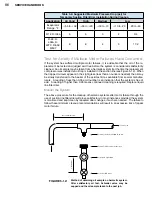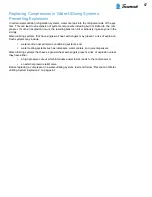
83
7. If a suction line accumulator is present, charge into the accumulator to prevent liquid
refrigerant from reaching the compressor. If this is not possible, then break the vacuum
by allowing refrigerant vapor to enter the low side at the suction service valve. When
the system pressure reaches 60 psig for R-22 (70 psig for R-502 & R-404A, 35 psig for
R-12 & R-134a), start the compressor and continue charging at rate not more than 5
pounds per minutes for the larger systems and somewhat less for smaller systems.
Follow the safety precautions outlined in “System Charging” on page 5.
8. Check fans and blowers for correct direction of rotation, belt tension, and proper air
flow (CFM).
9. With the protective terminal cover securely fastened, run the compressor and allow
the system pressures and temperatures to stabilize. Systems vary in their operating
characteristics, but generally these approximations will apply:
Table 5-6: Pressure and Temperature Stabilization
Pressure
Temperature
Saturated head pressure
Ambient temperature °F + 20°F for air cooled
condenser
Water cooled
Discharge water °F + 10°F
Saturated evaporator pressure
Air conditioning
Discharge air °F -20°F
Medium temperature
Product temperature -10°F to -12°F
Low temperature
Product temperature -6°F to -8°F
10. Before leaving the job, run the system for a while. Listen for abnormal noises. Feel
the bottom crankcase housing and determine that it is warm. Is the compressor upper
housing sweating indicating that liquid refrigerant is reaching the compressor? Is the
return gas temperature at the compressor within proper limits for the application (i.e.
not too low to cause flooding or not too high to produce high discharge and motor
temperatures)? Recheck pressures, amps, fan motors, belts, CFM, etc.
System Cleanup and Compressor Replacement After Com-
pressor Failure
Once you determine that a compressor needs to be replaced, you must determine whether the
system has been contaminated. Compressor motor failure can lead to such contamination. (While
compressor motor failure is sometimes referred to as motor “burnout,” it does not mean that a fire
actually occurs inside a hermetic compressor.) Even small amounts of contamination must be
removed from the system to avoid damaging the replacement compressor. Therefore, it is impor-
tant to thoroughly clean a refrigeration/air conditioning system if system contamination is present.
If a compressor motor failure has occurred, refrigerant or mixtures of refrigerant and oil in
the system can be acidic and can cause chemical burns. As always, to avoid injury, wear
appropriate protective eye wear, gloves and clothing when servicing an air conditioning or
refrigeration system. If refrigerant or mixtures of refrigerant and oil come in contact with skin
or eyes, flush the exposed area with water and get medical attention immediately.
The following outlines a process for compressor replacement and system clean-up for a system
equipped with a Tecumseh compressor. You should refer to the original equipment manufac-
turer’s (OEM) service information.
!
WARNING
Summary of Contents for AH5540E
Page 1: ...Hermetic Compressor Service Handbook Wholesale Distribution North America...
Page 2: ......
Page 3: ...Hermetic Compressor Service Handbook Ann Arbor MI 48108 REV 3 11...
Page 4: ......
Page 8: ......
Page 9: ...Chapter 1 General Service Safety Precautions...
Page 16: ......
Page 17: ...Chapter 2 Model and Application...
Page 22: ......
Page 23: ...Chapter 3 Compressor Motor and Component...
Page 36: ......
Page 37: ...Chapter 4 Servicing...
Page 38: ...30 SERVICE HANDBOOK...
Page 79: ...71...
Page 80: ......
Page 81: ...Chapter 5 Installation and Replacement...
Page 96: ......
Page 97: ...Liquid refrigerant migration to compressor FIGURE 6 1 Chapter 6 Operation...
Page 108: ......
Page 109: ...Appendix...
Page 113: ...105 Reciprocating Compressor FIGURE A 2 Internal view of typical air conditioning compressor...
Page 118: ...110 SERVICE HANDBOOK Notes...
Page 119: ......
















































